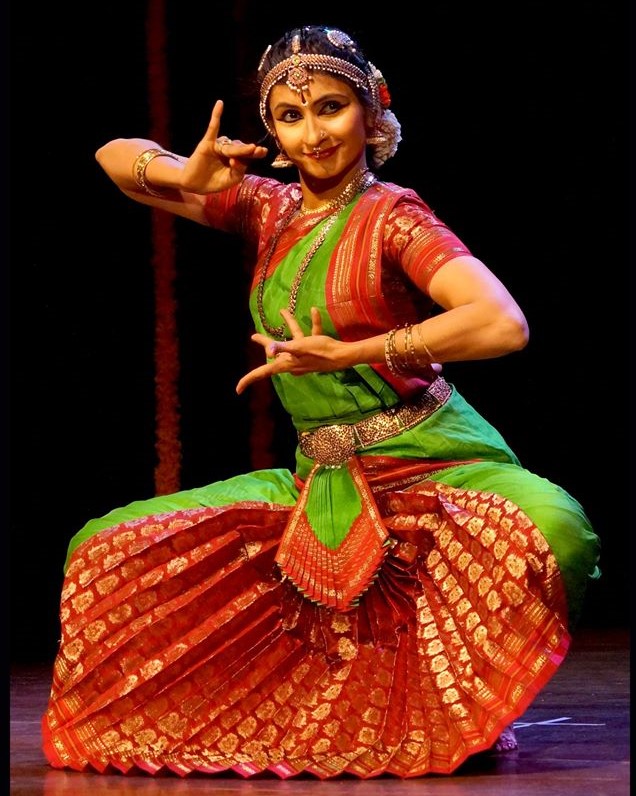- Home
- Gatika
- Artistic Director
- About Us
- Gallery
- Out Reach
- Classes
- Events
- Clients
- Press
- Blog
- Choreography
Bharatanatyam
ONLINE CLASSES
Monday, Tuesday & Friday : 4pm to 5pm IST (Batch 1)
5:10pm to 6:10pm IST (Batch 2)
Sunday : 8am to 9am IST (Batch 1)
9:15am to 10:15am IST (Batch 2)
Bharatanatyam is an Indian Classical dance form from Tamil Nadu and Karnataka. It is believed to have its origins in the Natyashastra, a text of Indian Dramaturgy and Aesthetics. Ever since the revival of this dance form, after India gained independence in 1947, it has evolved beautifully and has seamlessly integrated into contemporary times.

Brief notes on some of the terminologies used in Bharatanatyam:
Adavu: The basic rhythmic unit of dance that includes postures and movements of the Anga, Pratyanga and Upanga. Adavus are executed within a specific tempo and time structure.
Panchadasha adavus: Fifteen sets of adavus that are practiced to gain mastery over the execution of movement. Each set of adavu has at least four variations.
Anga: Major limbs comprising of head, neck, two palms, chest, the two sides of the body, two sides of the waist, and the two feet.
Pratayanga: Subsidiary limbs comprising of the two shoulders, two arms, stomach, thighs, shanks, wrists, knees and elbows
Upanga: Minor limbs comprising of eyes, eye brows, eye lids, pupils, cheeks, nose, jaws, lower lip, teeth, tongue, chin, face, heels, ankles, fingers, soles.
Sthanaka: The resting posture of a dancer before the beginning of a movement or at the end of a movement with varied positions of the feet.
Nritta: Pure dance technique comprising of a combination of adavus, without any emphasis on the expression of emotions.
Saushtava: It is attained when the Angas, Upangas and Pratyangas of the body are well co ordinated and in harmony with the mind, thus achieving an energetic and aesthetic presentation of dance.
Abhinaya: Communicating the meaning of the lyrics of a song to the spectators using facial expressions and body movements. Emotions or Bhavas play an important role in conveying the meaning to achieve aesthetic experience or Rasa in the spectators. Abhinaya could be broadly classified as Angika (Body movements and gestures), Vachika (Voice and speech), Aharya (Costume, make up and stage decor) Satttvika (Emotional responses)
Alaripu: Literally means “blossoming of a flower”. Traditionally, it is the first dance number taught in the repertoire of Bharatanatyam Margam.
Jatiswaram: A Nritta presentation, devoid of any Abhinaya, comprising of a jati, followed by adavus in various combinations, set to swaras (musical notes)

No comments yet.
BHARATANATYAM, KATHAK & CARNATIC VOCAL CLASSES – ONLINE and IN-PERSON Admissions open at Rustumbagh Layout, Off Old Airport Road, Bangalore
For Classes Contact +91 9845257113
GATIKA : Online Certified Bharatanatyam Intensive Program. Admissions open.
Movement Nuances Interactive YouTube Series on Rhythmotion India and on Instagram @rhythmotioninda
FKCCI Social Woman Entrepreneur Award bestowed on Chitra Arvind by The Federation of Karnataka Chamber of Commerce and Industry 9th March 2023
CHALANA 2021 – Online Festival of Dance & Music 25th to 31st December by all the Rhythmotion students on our YouTube channel Rhythmotion India
Online Kathak performance by Chitra and Alar Arvind FB Live https://fb.watch/9GRuyCDUFM/
See Annexure for more events
To book our performances and workshops
Contact: +91 9845257113
+91 9880027082
Founded in 2005 and registered as a Trust in 2008, Rhythmotion is a non profit Indian Classical and Contemporary dance and Music school that imparts training in Bharatanatyam, Kathak, Contemporary dance. Yoga, Body Conditioning, Nattuvangam, and Carnatic Vocal music. Artistic Director Chitra Arvind is the force behind Rhythmotion.
Rhythmotion Dance Company and Chitra Arvind represented India at the prestigious Busan International Dance Festival 2018, South Korea BIDF 2018 Sponsored by the Indian Council for Cultural Relations, Ministry of External Affairs, Govt of India and Indian Embassy Seoul.

You must be logged in to post a comment.